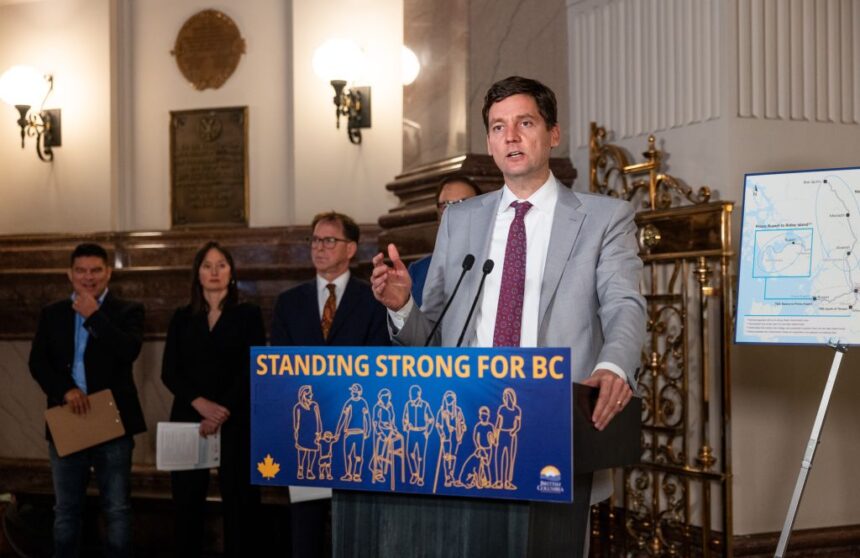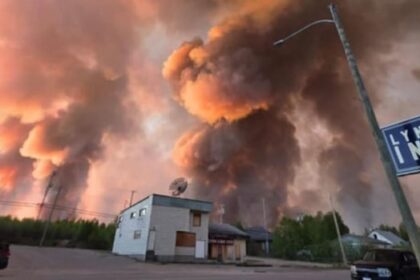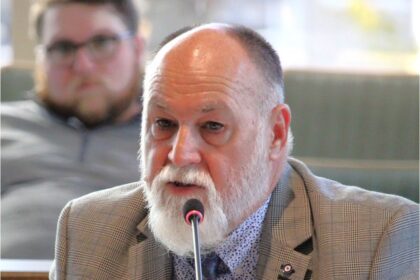Facing an “unprecedented demand for electricity” from industrial customers, the B.C. government is planning to make big changes to the rules for plugging into the provincial grid. New policies and legislation will prioritize power for natural resource sector projects — liquefied natural gas (LNG), mines and ports — while restricting access for AI and data centres and freezing out cryptocurrency operations entirely. “B.C. will be the economic engine that drives a more independent Canadian economy — powered by clean energy, built through partnership with First Nations and driven by the hard work of British Columbians,” Premier David Eby said in a press release following the introduction of Bill 31 in the legislature on Monday. The Energy Statutes Amendment Act will make it possible for First Nations to purchase an ownership stake in the North Coast transmission line. The multiphase project, led by BC Hydro, will involve building new high voltage transmission lines between Prince George and Terrace — a distance of about 450 kilometres — and expanding or upgrading other electricity transmission infrastructure along the way. The third phase involves building 350 kilometres of high-voltage transmission line from Terrace to Bob Quinn Lake, near the Alaska border.The first two phases of the project are currently expected to cost $6 billion — up from an estimated $3 billion in 2023, according to the energy ministry. Phase 3 of the project does not yet have a price estimate. Bill 31 will also give the province the power to set specific terms for certain industrial projects seeking access to electricity. This includes AI and data centres, cryptocurrency mining operations and facilities producing hydrogen for export. B.C.’s current ban on new cryptocurrency mines will be made permanent, while AI and data centres will have to compete for a limited amount of power, starting in January 2026. Going forward, BC Hydro will allocate 300 megawatts for AI centres and 100 megawatts for data centres every two years, with preference for projects that improve data sovereignty, create local jobs and come from B.C. or Canadian firms, per the government’s press release. Further details will be laid out in regulations later this fall. Green Party MLA Jeremy Valeriote decried the lack of detail contained in a bill that will give the government broad powers.“It’s déjà vu — the government is giving themselves unchecked authority, just like bills 14 and 15,” he said in a statement. “With no detail on this framework or the criteria for decision-making in Bill 31, we are concerned that the minister will be the one making these consequential determinations under the influence of friends or lobbyists.” Bill 31: why this, why now Bill 31 is the second piece of the legislation the B.C. government has introduced this year with the aim of pushing the transmission line forward. Bill 14, the Renewable Energy Projects (Streamlined Permitting) Act, passed this spring, exempting the North Coast transmission line and other renewable energy projects from environmental assessments. The new law put the BC Energy Regulator, a Crown corporation that oversees oil and gas operations, in charge of renewable energy projects as well as major new transmission lines. According to BC Hydro, the new transmission lines could affect as many as 101 private properties, including agricultural land. The North Coast transmission line would cut through traplines and woodlots, and cross waterways that include habitat for at-risk white sturgeon and fall within 200 metres of archeological sites. Usually such a significant project would require a certificate from the B.C. Utilities Commission, confirming that it is needed and in the public interest. The commission’s reviews are public and can include submissions from stakeholders, First Nations and members of the public. But the B.C. government believes the North Coast transmission line is in the public interest and does not want to wait for that to be confirmed via the commission, a process Eby said could take up to 18 months. Instead, the B.C. government intends to order the commission to issue a certificate for the project. The North Coast transmission line will power energy-intensive industries, including LNG export terminals, along B.C.’s north coast. Photo: Province of B.C. / Flickr “We are making the decision as a government that this is in our public interest,” Eby said. “We will be held accountable for that decision by voters. But to my mind, there is no debate with this. This transmission line will open up economic development in an entire region of our province … This will lift local communities out of poverty. This will create almost 10,000 jobs.”He likened the North Coast transmission line to “a big revenue machine for communities, families and government.”“It just needs to be plugged in,” Eby told reporters. Valeriote called the North Coast transmission line “another public subsidy for resource extraction” and pointed out that few of the projects the line would supposedly service have even committed to moving forward. “This government’s urge to label resource extraction in B.C. as ‘clean’ energy compared to others is like claiming the end of the guillotine is the end of capital punishment — it’s a change in the execution, not in the result,” Valeriote said in a statement. B.C. government plans to make it cheaper for industries to connect to the grid Not many people live in the corner of B.C. where the North Coast transmission line, capable of delivering 2,200 megawatts of electricity, will run. But companies keen to green their mining, LNG and hydrogen production operations are eager to get access to the electricity it will carry. When BC Hydro conducted a survey in 2023 to assess industrial demand for electricity in northwest B.C., companies pitched projects that could soak up nearly 5,000 megawatts of potential industrial load — about five times the capacity of the Site C dam, according to the government.“The North Coast transmission line is a nation-building project that will deliver clean electricity to power mines, to power our port expansions, to reduce emissions from LNG facilities, all in partnership with First Nations and communities,” Eby said. “It will mean major industrial connections for sectors like mining, natural gas and manufacturing are prioritized.” The premier estimated the projects interested in connecting to the North Coast transmission line could add more than $9.8 billion to B.C.’s gross domestic product every year and generate $1 billion in revenues for the province. Electrifying what would otherwise be prolific polluters could also save two to three million tonnes of carbon dioxide emissions per year, Eby said. An entire transmission line dedicated to powering industrial projects might seem like a very generous gift from the provincial government, but Eby plans to go further. In addition to building the North Coast transmission line, the B.C. government is planning to change the rules so industrial customers don’t have to pay the full charge currently levied for connecting to the power grid. “Outdated rules make it too difficult and too costly for major projects to get to that final investment decision and make that decision to build and employ people and build our prosperity,” Eby said. “We intend to make it easier for companies to make that final decision by getting them access to clean, sustainable power at fair rates, without billions of dollars of upfront cost that can stifle investment.” Premier David Eby says his government plans to change a rule that requires new industrial customers to pay for transmission infrastructure for projects that need more than about 150 megawatts of electricity. Photo: Marty Clemens / The Narwhal The rule Eby referenced — known as tariff supplement 6 — requires new industrial customers seeking more than about 150 megawatts of power to pay the incremental costs of generating and transmitting the power that exceeds that threshold.The rule has been on BC Hydro’s books since 1991 and is based on the “cost of adding a new gas-fired generation plant” to BC Hydro’s roster. Tariff supplement 6 has rarely been applied. The Cedar LNG facility near Kitimat, B.C., was one of the first projects to trigger it. The facility will use 214 megawatts and recently received $200 million from the province to help cover the cost of the infrastructure and upgrades needed to link the project to B.C.’s power grid. Tariff supplement 6 is meant to protect other BC Hydro customers from being hit with higher electricity prices as a result of investments to serve large industrial customers. But a briefing note prepared for Eby in March 2024 concluded that requiring LNG, mining and other companies to pay those costs “could be prohibitive,” and that the province should consider a new approach “to balance industrial competitiveness with electrification in other sectors of the economy, all while keeping rates affordable.”The province is planning to tweak the transmission portion of tariff supplement 6 to make sure the costs aren’t prohibitive for industrial customers. Asked by The Narwhal what measures his government plans to take to ensure BC Hydro’s other ratepayers don’t see higher power bills as a result of that change, Eby pointed out that B.C. has historically had very low electricity rates. “That benefit of having low [BC] Hydro rates is an advantage that we can leverage to grow our economy,” he said, adding that keeping rates affordable is a key priority for his government. “When you have a major investment — like Site C — that creates efficient capacity across the system, that cost is shared by all ratepayers. That will continue to be the case going forward.” Recent Posts B.C. bets big changes to energy policy will reap massive rewards Oct. 20, 2025 7 min. read The province says Bill 31 will speed up construction of the $6-billion North Coast transmission… How plans for a sprawling subdivision near Ottawa’s Greenbelt are dividing the city Oct. 20, 2025 15 min. read The Tewin housing megaproject, backed by major developer Taggart Group, has city councillors and residents… The crisis — and opportunity — in Canadian forests Dwindling old-growth trees in British Columbia and devastating wildfires in Manitoba highlight the urgency of…
B.C. bets big changes to energy policy will reap massive rewards











